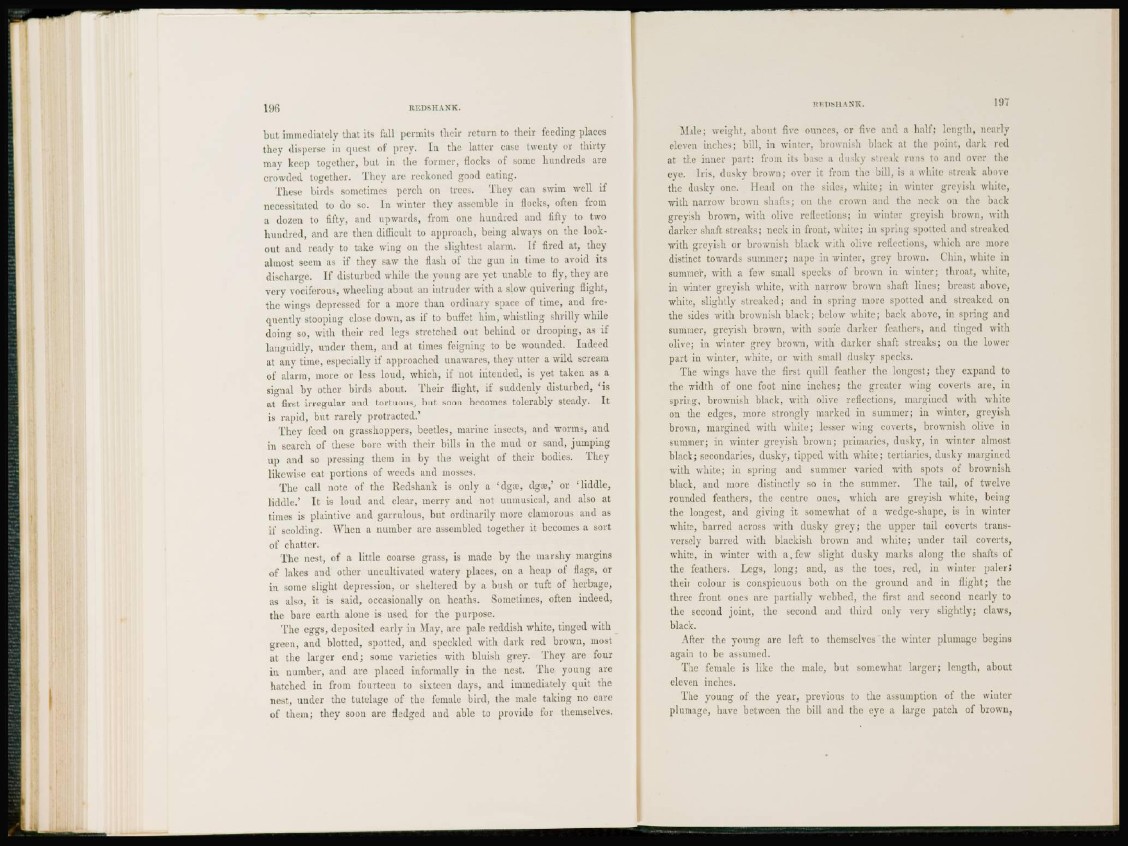
196 REDSHANK.
but immediately that its fall permits their return to their feeding places
they disperse in quest of prey. In the latter case twenty or thirty
may keep together, but in tlie former, flocks of some hundreds are
crowded together. They are reckoned good eating.
These birds sometimes perch on trees. They can swim well if
necessitated to do so. In winter they assemble in flocks, often from
a dozen to fifty, and upwards, from one hundred and fifty to two
hundred, and are then difficult to approach, being always on the lookout
and ready to take wing on the slightest alarm. If fired at, they
almost seem as if they saw the flash of the gun in time to avoid its
discharge. If disturbed while the young arc yet unable to fly, they are
very vociferous, wheeling about an intruder with a slow quivering flight,
the wings depressed for a more than ordinary space of time, and frequently
stooping close down, as if to buffet him, whistling shrilly while
doing so, with their red legs stretched out behind or drooping, as if
languidly, under them, and at times feigning to be wounded. Indeed
at any time, especially if approached unawares, they utter a wild scream
of alarm, more or less loud, which, if not intended, is yet taken as a
signal by other birds about. Their flight, if suddenly disturbed, ( is
at first irregular and tortuous, but soon becomes tolerably steady. It
is rapid, hut. rarely protracted.'
They feed on grasshoppers, beetles, marine insects, and worms, and
in search of these bore with their bills in the mud or sand, jumping
up and so pressing them in by the weight of their bodies. They
likewise eat portions of weeds and mosses.
The call note of the Redshank is only a *dga?, dga?,' or 'liddlc,
Hddle,' It is loud and clear, merry and not unmusical, and also at
times is plaintive and garrulous, but ordinarily more clamorous and as
if scolding. When a number are assembled together it becomes a sort
of chatter.
The nest, of a little coarse grass, is made by the marshy margins
of lakes and other uncultivated watery places, on a heap of flags, or
in some slight depression, or sheltered by a bush or tuft of herbage,
as also, it is said, occasionally on heaths. Sometimes, often indeed,
the bare earth alone is used for the purpose.
The eggs, deposited early in May, are pale reddish white, tinged with
green, aud blotted, spotted, and speckled with dark red brown, most
at the larger end; some varieties with bluish grey. They are four
in. number, and are placed informally in the nest. The young are
hatched in from fourteen to sixteen days, and immediately quit the
nest, under the tutelage of the female bird, the male taking no care
of them; they soon are fledged and able to provide for themselves.
REDSHANK. 197
Male; weight, about five ounces, or five and a half; length, nearly
eleven inches; bill, in winter, brownish black at the point, dark red
at the inner part: from its base a dusky streak runs to and over the
eye. Iris, dusky brown; over it from the bill, is a white streak above
the dusky one. Head on the sides, white; in winter greyish while,
with narrow brown shafts; on the crown and the neck on the back
greyish brown, with olive reflections; in winter greyish brown, with
darker shaft streaks; neck in front, white; in spring spotted and streaked
with greyish or brownish black with olive reflections, which are more
distinct towards summer; nape in winter, grey brown. Chin, white in
summer, with a few small specks of brown in winter; throat, white,
in winter greyish white, with narrow brown shaft lines; breast above,
white, slightly streaked; and in spring more spotted and streaked on
the sides with brownish black; below white; back above, in spring and
summer, greyish brown, with sonic darker feathers, aud tinged with
olive; in winter grey brown, with darker shaft streaks; on the lower
part in winter, white, or with small dusky specks.
The wings have the first quill feather the longest; they expand to
the width of one foot nine inches; the greater wing coverts are, in
spring, brownish black, with olive reflections, margined with white
on the edges, more strongly marked in summer; in winter, greyish
brown, margined with white; lesser wing coverts, brownish olive in
summer; in winter greyish brown; primaries, dusky, in winter almost
black; secondaries, dusky, tipped with white; tertiarics, dusky margined
with white; in spring and summer varied with spots of brownish
black, aud more distinctly so in the summer. The tail, of twelve
rounded feathers, the centre ones, which are greyish white, being
the longest, and giving it somewhat of a wedge-shape, is in winter
white, barred across with dusky grey; the upper tail coverts transversely
barred with blackish brown and white; under tail coverts,
white, in winter with a, few slight dusky marks along the shafts of
the feathers. Legs, long; and, as the toes, red, in winter paler;
their colour is conspicuous both on the ground and in flight; the
three front ones are partially webbed, the first and second nearly to
the second joint, the second and third only very slightly; claws,
black.
After the young are left to themselves the -winter plumage begins
again to be assumed.
The female is like the male, but somewhat larger; length, about
eleven inches.
The young of the year, previous to the assumption of the winter
plumage, have between the bill and the eye a large patch of brown,